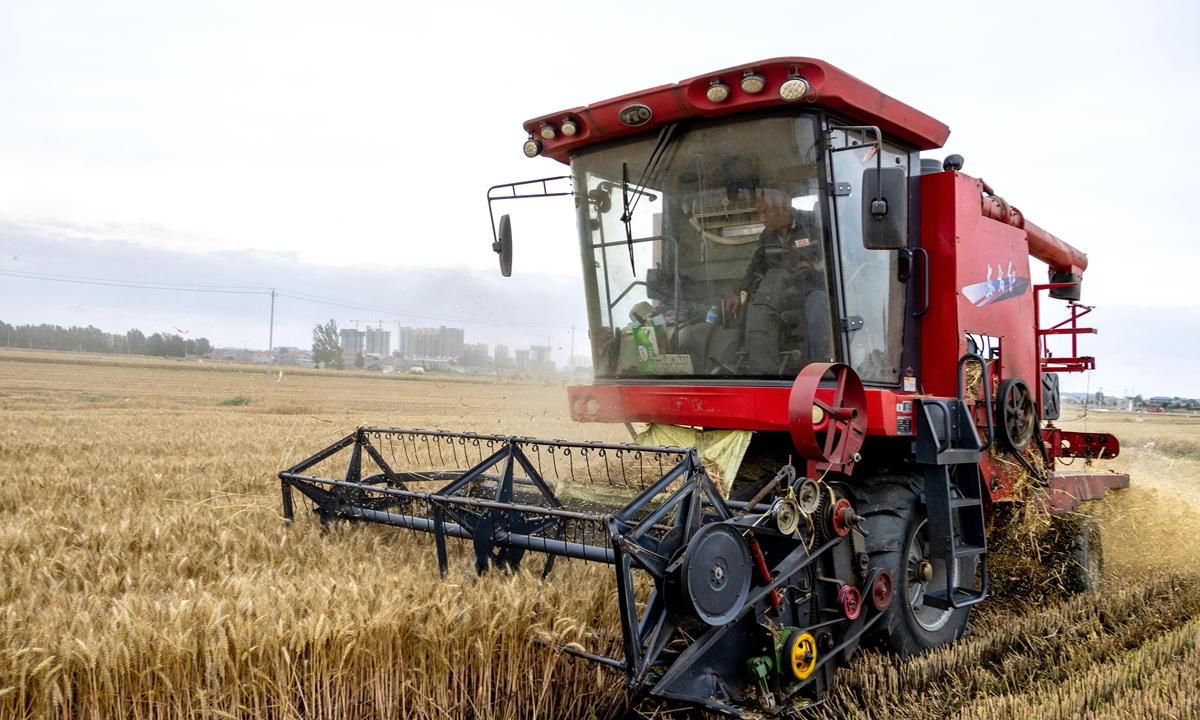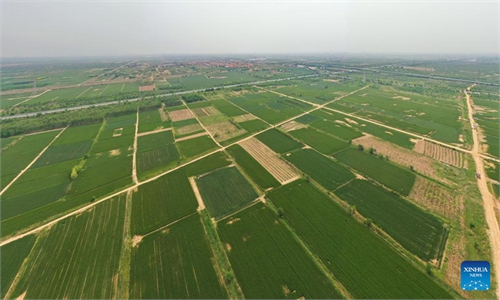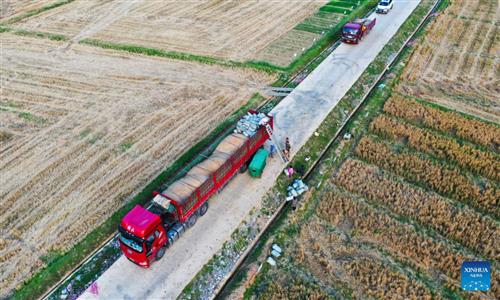
A farmer uses a machine to harvest wheat in Huaxian county in Central China's Henan Province on June 4, 2023. Photo: VCG
While China has comprehensively kicked off the harvest season of winter wheat nationwide from southern to northern areas, certain places have had continuous rain. Farmers are racing against time to harvest and dry the crops with the help of measures rolled out by governments.
As of 8 am on Sunday, Central China's Henan Province had harvested 47.58 million mu (3.17 million hectares) of winter wheat, accounting for 55.8 percent of its total, China Media Group reported.
As a major wheat producer in China, Henan had persistent rain recently during the critical harvest period, which has been called the worst scenario in a decade. In order to minimize the impact, farmers have been working in the fields day and night with harvesters in operation 24 hours a day.
The province has prepared 4 million pieces of agricultural machinery, 200,000 combine-harvesters, 30,000 crawler type harvesters, 4,660 dryers and other items to ensure production. The harvest season of about 20 days is expected to end around June 15 in the province, according to media reports.
Counties in Henan have organized machinery repair teams since mid-April to help farmers overhaul and maintain machinery. More than 600 emergency service teams and 18 expert teams have arrived in the fields to guide the harvesting. Farmers have been encouraged to make full use of field roads, schools, squares, roofs of houses and other idle sites to seize the opportunities of good weather to dry wheat.
Henan has appropriated an emergency fund of 200 million yuan ($28.23 million) to dry wheat and ensure the quality of the crop. Local agricultural insurance underwriters have been guided to do their best to settle wheat insurance claims so as to guarantee farmers' profits, reports said.
The rainy weather was mainly seen across the Huang-Huai-Hai region this time, which includes Henan and East China's Anhui, Shandong and Jiangsu Provinces. "We have finished the majority of the harvesting, faster than those in surrounding villages," Song Kun, a farmer from Huaibei, Anhui, told the Global Times on Sunday.
"The whole process of harvesting is quick, as a unit of combine-harvester can reap about 80-90 mu of wheat a day," Song said, and they are working until 10 pm in recent days.
But his work was halted on Sunday due to the rain and the rest of the crop in the field may germinate, he said, noting that germination means bad quality and, therefore, lower prices.
As for the areas getting rain, such as Henan, their wheat may see lower grades in the market this year, Jiao Shanwei, editor-in-chief of industry news website cngrain.com, told the Global Times.
However, there will be a limited impact on the overall harvest across the nation, experts said.
"So far, the impact was mainly limited to certain areas. Even in Henan, the disaster-level weather is mainly seen in its southern parts," Li Guoxiang, a research fellow at the Chinese Academy of Social Sciences, told the Global Times.
The Yangtze River basin, where the wheat harvest started earlier, has not been affected, Li said.
As of Friday, Southwest China's Sichuan and Central China's Hubei had started wrapping up their harvesting for this season. The daily harvest area across the nation exceeded 10 million mu for three consecutive days, according to the Ministry of Agriculture and Rural Affairs.
Given that bad weather is becoming more and more frequent, Chinese authorities have stepped up efforts to establish coping mechanisms to ensure overall output and guarantee farmers' interests, experts said.
Different departments working together to help farmers with the grain harvesting and storage is a vivid reflection of localities shouldering the important task of stabilizing food security, Li said.
Annual grain output in China has remained steady at more than 650 million tons for eight years in a row, official data showed.


